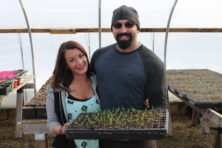Kittydom on an Iowa Farm
- Share
- Tweet
- Pin
- Share
The morning after arriving at my sister’s home for my yearly visit, I hiked the quarter-mile lane to the farmstead of barns and various sheds to check out my nephew Dave’s perennial cat crop. At a high point in the lane, I stopped to view the cottonwood trees, five miles away, which marked the homestead where I had grown up with several siblings – and kittens.
At age four I had taken on the task of naming and taming the cats and kittens that wandered the outbuildings and cornfields of our Iowa farm. When the many new litters exceeded my kitty-naming ability, I began to recycle favorite names such as Affectionetty II or Twinkle Toes III, honoring kitten aunts whose coloration or disposition they resembled. Were any of those loved pets the ancestors of the cats I was about to meet, I wondered.
Cat radar seemed to have anticipated my arrival. First to appear was a skinny mama leading a parade of six black-and-white kittens, tails unfurled in the autumn air. Simultaneously, an orange-and-white feline family emerged from the barn’s upper floor. While they were still finding their way to the ground, black-and-white mama led her progeny in the art of wrapping their soft bodies around and between my legs, mewing prettily and cocking their heads in an irresistible fashion. Soon they were in my arms, where the cuddly balls of fur vibrated with contented purrs.
Over several years of kitty-visiting, I learned from Dave that inhabiting the upper floor did not earn upper-class status for the orange-and-white cat population. Rather, it was the black-and-white family below which had usurped the rank of aristocracy. Let some curious upper-kitten unfamiliar with the ways of local cat-dom place a tentative paw on the first step of the barn ladder, intending to descend to the lower flat. In a flash the aristocats below greet it with a great caterwauling, chorus of ffffzzzzsts, and showing of fangs, causing the little innocent to race back up and seek shelter behind the farthest and fattest hay bail.
One feature that differentiated the two cat classes, Dave informed me at an early cat-visit, was their way of exiting the barn when going to work to feed the family. The aristocats would be out in a meow, by way of the nearest aperture. For the feline peasants upstairs, however, exiting the premises required the art of jumping from an upstairs window to the upper frame of a lower window and then to the earth, made soft and spongy by the residue of many bovine generations. Only rarely did an upper-cat dare to enter the aristocats’ sacred space when the owners were not at home.
A second distinguishing mark of the two families was their way of spending cold winter months when, instead of having to search frozen acres for the small rodents that made up their staple diet, their food literally came indoors to them. Like their human counterparts who used the season to repair machinery and sharpen tools, the aristocats occupied themselves for many hours in the business of sharpening their claws on window frames and barn doors once redolent with the dung of cows and straying chickens. The upper-floor cats, deprived of such handy claw-sharpening accoutrements as doorposts and reachable window frames, had a perfectly valid excuse to lie around and become fat cats. However, they chose fitness to fatness, sharpening claws on the floor itself, perhaps understanding that their survival depended upon the ability to outrun their food supply before they ran out of it.
On this particular visit, all evidence of the cat caste system I had learned to expect had disappeared. Mewing around me as they waited for pick-up were black-and-white kittens, black-and-orange kittens, and black-white-and-orange kittens. Several rubbed against my pant legs. Others twisted and twined around each other with obvious affection.
“What happened?” I asked my nephew.
Just then a handsome black-white-and-orange tomcat emerged from the barn to join his families.
“Oh,” I said.
Dave smiled.


